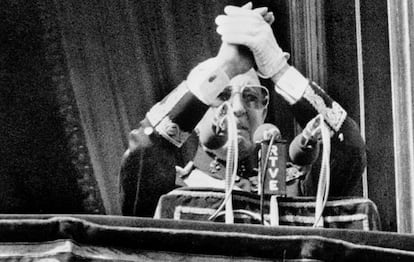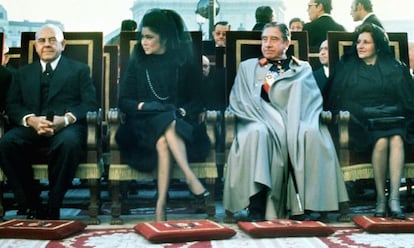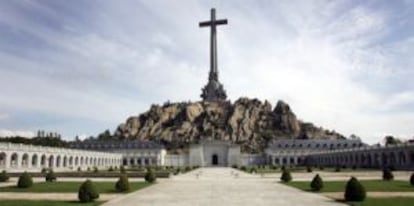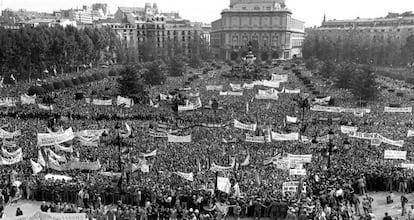Remnants of the Franco era
The dictatorship endures in some people's nostalgia for messianic solutions

Neither the education system nor collective memory have done enough to help clarify Spain’s ideas about Francisco Franco, the dictator who died 40 years ago today.
His remains are still there, buried under a 1.5-ton flagstone that was sealed on November 23, 1975 at a brief ceremony attended by a few foreign leaders, among them another military ruler like himself, Augusto Pinochet
One way to remember the nature of that regime is to look through our grandparents’ trunks or in flea markets. Pick up a coin from that time, and on it you will read: Francisco Franco, Caudillo of Spain by the grace of God, and underneath the legend, the face of the soldier who was chiefly responsible for the horrors committed during the Civil War – with the help of Mussolini and Hitler – and of further repression carried out under his subsequent regime.

The regime’s propagandists found in the Christian God the legitimizing force that was needed to create the cult of Franco, who would in turn be dubbed “Generalissimo of the armed forces” or “the guardian of the West” to justify a regime with no civil rights or free elections, where the people had no say in things, and where there was only one political party, the National Movement. This was a regime tailor-made for a dictator who, to use the words of historian Santos Juliá, “abominated the 20th century, hated liberalism, and despised democracy,” (EL PAÍS, 3/12/1992).
The remnants of Franco
Some of Franco’s obsessions have survived. Philosopher Fernando Savater warned some time ago about the toxic waste left behind by decades of Francoist contamination; for example, “the dislike of ‘politics’ and ‘politicians’ that leads so many people to repeat one of the dictator’s favorite sayings: ‘Do like I do, and don’t get involved in politics’” (EL PAÍS, 20/11/1992). Forty years after the death of the dictator, the CIS sociological research institute still asks people, literally, “if it is better not to get involved in politics.” And 43.6 percent agree, according to the latest survey.
It isn’t hard to see the mistrust of the authoritarians toward democracy, for example, in their approach to elections when they see they aren’t going to win a crushing majority, as though the apathy or disinterest of the electorate proved that politics and political parties are seen as equally loathsome. One only has to observe the agitation provoked by cross-party pacts, along with the disqualifying of anybody who criticizes the government’s control over other constitutional powers and civil society; in short, in not having accepted the give-and-take that goes with democracy.
The statues of Franco were taken down a long time ago. But the controversy continues over streets and buildings that retain names linked to the dictatorship, in tandem with the shortage of money to find and exhume the bodies of those shot and buried in mass graves. Forty years after the death of the dictator, there are still streets named after generals who led the military uprising.

The government of Adolfo Suárez had the courage to remove the huge fascist symbols that decorated the headquarters of the National Movement prior to the 1977 elections; while today, it is clear that there are still those who resist finishing the job of erasing any memory of Franco. The other side of the coin is the refusal to recognize the existence of Spain by regional separatists, reflected in their intolerance of Spanish symbols (flag, national anthem).
Another aspect of public life today connects with a practice used in the final years of Franco: the obsession with counting attendance at protest marches. Many such demonstrations have been reported in hugely exaggerated terms. According to state broadcaster TVE’s news report from the time, one million people gathered in Madrid’s Plaza de Oriente on October 1, 1975 to show their support for Franco’s decision to execute five people by firing squad (“To the wall, to the wall!” they were heard to shout). Weeks later, the state media reported long lines outside the chapel where Franco lay in state.
Strangely enough, Spain’s democracy seems to have inherited many of the same approaches toward protest marches: there are never fewer than one million people according to the organizers, whether they be Catholics opposed to abortion rights during the previous Socialist administration, or Catalan separatists marching for independence. Vestiges of the Franco era or not, the propagandists of today have as little respect for the truth as state television did back in 1975 in exaggerating the supposed popular support for the dictator.
A free market with no freedoms
Francoism, which brought together Catholicism, the crypto-fascism of the Falange, along with the monarchism of the Carlists, rested on the middle classes, who supposedly provided stability. Once the first phase of the autarky had passed, Franco’s goal was to create “a kind of modern market economy, but without political freedoms, something like the Chinese are attempting.”
The comparison, made by Savater (EL PAÍS 20/11/1992) is apt, even if Franco never quite made it that far. The oil crisis of the early 1970s is what really did for the Franco regime: inflation reached almost 20 percent a year, doubling in just a few years, and destroying the gains made by the salary increases conceded under the national-syndicalist system.
The regime was unable to combat the problem, and seemed much more concerned about what was going on in Portugal, where junior army officers had overthrown the Salazar dictatorship in April 1974, as well as about the threat posed by student and worker agitation, mounting terrorism from ETA, along with growing opposition within sectors of the Catholic Church.
One way to remember the nature of that regime is to look through our grandparents’ trunks or in flea markets
The execution of five people just a few weeks before the death of Franco further isolated a country that was in the process of losing its African colony of Western Sahara to Morocco and Mauritania, exposing the weakness of a regime led by a man on his deathbed, and who would finally expire on November 20, 1975.
The hardcore of the regime dug in for the fight, while society began to see glimmers of personal freedoms, despite the fact that women still needed their husband’s permission to open a bank account, in a society where divorce and abortion were taboo.
There were those who believed that a Francoist monarchy was the way to extend the dictatorship. The last head of Franco’s government, Carlos Arias Navarro, tried this for a few months, until King Juan Carlos quietly sacked him and replaced him with Adolfo Suárez, effectively beginning the transition to democracy. Across the divide, those who wanted a complete break with the past were also to be disappointed.

The pact between these two main forces explains the process by which Spain began moving from dictatorship to democracy, as well as the criticism expressed by those who believed that it was a betrayal of democracy. The elections of June 1977, followed the next year by the referendum on the Constitution, laid the foundations for normalization.
It’s true that along the way, Franco’s henchmen were given immunity from prosecution in return for an amnesty that included crimes by the former regime’s opponents. Much has been forgotten along the way, bringing some discredit to the country’s democracy. It is also true that the decision to forget the past has obscured the tragic reminder of the political crimes that peppered those early years of democracy (different factions within ETA, the ultra-leftist GRAPO, and the far right).
What has also been forgotten are the attempted coups that took place in the years after the death of Franco (“Power to the army!” “Come back Franco, Spain needs you!” The failure of the 1981 coup finally reduced the far right to impotence.
Needs going nowhere
It would be absurd to argue that a constitutional regime has hobbled democracy. On the contrary, it was the means that allowed the political process to take place, while Constitutional procedures have always been observed during elections.
The reforms carried out by Adolfo Suárez are no longer questioned, not even by his traditional enemies. And neither are those that Felipe González introduced, including the creation of an armed forces at the service of the state, universal health care, and Spain’s membership of the European Union.
It is true that urgent action is required to address many political issues, and that the political system has been largely discredited as a result of widespread corruption over the last 40 years. But whatever action needs to be taken in those regards, the fundamentals of the Constitution – the outcome of the most important political pact in modern Spain – remain as solid as ever.
It is somewhat disheartening that with so many positive points in their favor, so many Spaniards are still divided over how to interpret their recent past. Equally saddening is the lack of perspective on the part of those who would attack our current system of government head on, and who themselves perhaps are unconsciously nostalgic for messianic solutions.
Tu suscripción se está usando en otro dispositivo
¿Quieres añadir otro usuario a tu suscripción?
Si continúas leyendo en este dispositivo, no se podrá leer en el otro.
FlechaTu suscripción se está usando en otro dispositivo y solo puedes acceder a EL PAÍS desde un dispositivo a la vez.
Si quieres compartir tu cuenta, cambia tu suscripción a la modalidad Premium, así podrás añadir otro usuario. Cada uno accederá con su propia cuenta de email, lo que os permitirá personalizar vuestra experiencia en EL PAÍS.
En el caso de no saber quién está usando tu cuenta, te recomendamos cambiar tu contraseña aquí.
Si decides continuar compartiendo tu cuenta, este mensaje se mostrará en tu dispositivo y en el de la otra persona que está usando tu cuenta de forma indefinida, afectando a tu experiencia de lectura. Puedes consultar aquí los términos y condiciones de la suscripción digital.








































